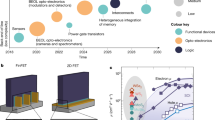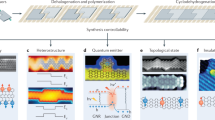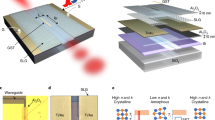Abstract
As silicon-based electronics approach the limit of improvements to performance and capacity through dimensional scaling, attention in the semiconductor field has turned to graphene, a single layer of carbon atoms arranged in a honeycomb lattice. Its high mobility of charge carriers (electrons and holes) could lead to its use in the next generation of high-performance devices. Graphene is unlikely to replace silicon completely, however, because of the poor on/off current ratio resulting from its zero bandgap. But it could be used to improve silicon-based devices, in particular in high-speed electronics and optical modulators.
This is a preview of subscription content, access via your institution
Access options
Subscribe to this journal
Receive 51 print issues and online access
$199.00 per year
only $3.90 per issue
Buy this article
- Purchase on Springer Link
- Instant access to full article PDF
Prices may be subject to local taxes which are calculated during checkout





Similar content being viewed by others
References
Kim, K. From the future Si technology perspective: challenges and opportunities. Tech. Digest Int. Electron Devices Meet. 10, 1–9 (IEEE, 2010).
Novoselov, K. S. et al. Two-dimensional atomic crystals. Proc. Natl Acad. Sci. USA 102, 10451–10453 (IEEE, 2005).
Novoselov, K. S. et al. Two-dimensional gas of massless Dirac fermions in graphene. Nature 438, 197–200 (2005).
Zhang, Y. et al. Experimental observation of the quantum Hall effect and Berry's phase in graphene. Nature 438, 201–204 (2005).
Novoselov, K. S. et al. Electric field effect in atomically thin carbon films. Science 306, 666–669 (2004). This paper reports the discovery of graphene by deposition of a graphene monolayer on a silicon substrate and the measurement of its field effect mobility to demonstrate its potential for electronic application.
Bolotin, K. I. et al. Ultrahigh electron mobility in suspended graphene. Solid State Commun. 146, 351–355 (2008).
Liu, M. et al. A graphene-based broadband optical modulator. Nature 474, 64–67 (2011). This paper demonstrates an optical modulator using graphene for the first time.
Xia, F. et al. Ultrafast graphene photodetector. Nature Nanotechnol. 4, 839–843 (2009).
Geim, A. K. & Novoselov, K. S. The rise of graphene. Nature Mater. 6, 183–191 (2007).
Liao, L. et al. High-speed graphene transistors with a self-aligned nanowire gate. Nature 467, 305–308 (2010).
Avouris, P. et al. Graphene-based fast electronics and optoelectronics. Tech. Digest Int. Electron Devices Meet. 10, 552–555 (IEEE, 2010).
Lee, J. et al. RF performance of pre-patterned locally-embedded-back-gate graphene device. Tech. Digest Int. Electron Devices Meet. 10, 568–571 (IEEE, 2010).
Lee, S. et al. Record RF performance of 45-nm SOI CMOS technology. Tech. Digest Int. Electron Devices Meet. 568–571 (IEEE, 2007).
Lai, R. et al. Sub 50-nm InP HEMT device with F max greater than 1 THz. Tech. Digest Int. Electron Devices Meet. 609–611 (IEEE, 2007).
Kim, D.-H. et al. 30-nm InAs pseudomorphic HEMTs on an InP substrate with a current-gain cutoff frequency of 628 GHz. IEEE Electron. Device Lett. 29, 830–833 (2008).
Singisetti, U. et al. Ultralow resistance in situ ohmic contacts to InGaAs/InP. Appl. Phys. Lett. 93, 183502 (2008).
Liao, L. et al. Sub-100 nm channel length graphene transistors. Nano Lett. 10, 3952–3956 (2010). This paper reports on a graphene transistor's performance, its feasibility and limits for radio-frequency applications, and suggests that graphene can outperform silicon-based radio-frequency transistors.
Schwierz, F. Industry-compatible graphene transistors. Nature 472, 41–42 (2011).
Meric, I. et al. Channel length scaling in graphene field-effect transistors studied with pulsed current−voltage measurements. Nano Lett. 11, 1093–1097 (2011).
Meric, I. et al. Graphene field-effect transistors based on boron nitride gate dielectrics. Tech. Digest Int. Electron Devices Meet. 10, 556–559 (IEEE, 2010).
Lin, Y.-M. et al. 100-GHz Transistors from wafer-scale epitaxial graphene. Science 327, 662 (2010).
Adam, S. et al. A self-consistent theory for graphene transport. Proc. Natl Acad. Sci. USA 104, 18392–18397 (2007).
Robinson, J. et al. Contacting graphene. Appl. Phys. Lett. 98, 053103 (2011).
Nagashio, N. et al. Metal/graphene contact as a performance killer of ultra-high mobility graphene analysis of intrinsic mobility and contact resistance. Tech. Digest Int. Electron Devices Meet. 9, 565–568 (IEEE, 2009).
Bolotin, K. I. et al. Temperature-dependent transport in suspended graphene. Phys. Rev. Lett. 101, 096802 (2008).
Hwang, E. H. et al. Carrier transport in two-dimensional graphene layers. Phys. Rev. Lett. 98, 186806 (2007).
Nomura, K. et al. Quantum Hall ferromagnetism in graphene. Phys. Rev. Lett. 96, 256602 (2006).
Chen, J.-H. et al. Intrinsic and extrinsic performance limits of graphene devices on SiO2 . Nature Nanotechnol. 3, 206–209 (2008).
Isigami, M. et al. Atomic structure of graphene on SiO2 . Nano Lett. 7, 1643–1648 (2007).
Meyer, J. C. et al. The structure of suspended graphene sheets. Nature 446, 60–63 (2007).
Deshpande, A. et al. Spatially resolved spectroscopy of monolayer graphene on SiO2 . Phys. Rev. B 79, 205411 (2009).
Dean, C. R. et al. Boron nitride substrates for high-quality graphene electronics. Nature Nanotechnol. 5, 722–726 (2010).
Xue, J. et al. Scanning tunnelling microscopy and spectroscopy of ultra-flat graphene on hexagonal boron nitride. Nature Mater. 10, 282–285 (2011).
Jeon, I. et al. Passivation of metal surface states: microscopic origin for uniform monolayer graphene by low temperature chemical vapor deposition. ACS Nano 5, 1915–1920 (2011).
Giovannetti, G. et al. Doping graphene with metal contacts. Phys. Rev. Lett. 101, 026803 (2008).
Xia, F. et al. The origins and limits of metal–graphene junction resistance. Nature Nanotechnol. 6, 179–184 (2011).
Heersche, H. B. et al. Bipolar supercurrent in graphene. Nature 446, 56–59 (2007).
Russo, S. et al. Contact resistance in graphene-based devices. Physica E 42, 677–679 (2010).
Grosse, K. L. et al. Nanoscale Joule heating, Peltier cooling and current crowding at graphene–metal contacts. Nature Nanotechnol. 6, 287–290 (2008).
Han, M. Y., Ozyilmaz, B., Zhang, Y. & Kim, P. Energy band-gap engineering of graphene nanoribbons. Phys. Rev. Lett. 98, 206805 (2007).
Chen, Z., Lin, Y. M., Rooks, M. J. & Avouris, P. Graphene nano-ribbon electronics. Physica E 40, 228–232 (2007).
Li, X. et al. Chemically derived, ultrasmooth graphene nanoribbon semiconductors. Science 319, 1229–1232 (2008).
Xia, F. et al. Graphene field-effect transistors with high on/off current ratio and large transport band gap at room temperature. Nano Lett. 10, 715–718 (2010).
Kim, M. et al. Fabrication and characterization of large-area, semiconducting nanoperforated graphene materials. Nano Lett. 10, 1125–1131 (2010).
Liang, X. et al. Formation of bandgap and subbands in graphene nanomeshes with sub-10 nm ribbon width fabricated via nanoimprint lithography. Nano Lett. 10, 2454–2460 (2010).
Bai, J. et al. Graphene nanomesh. Nature Nanotechnol. 5, 190–194 (2010).
Palacios, T. et al. Applications of graphene devices in RF communications. IEEE Commun. Mag. 48, 122–128 (2010).
Wang, H. et al. Graphene frequency multiplier. IEEE Electron Device Lett. 30, 547–549 (2009).
Lin, Y.-M. et al. Wafer-scale graphene integrated circuit. Science 332, 1294–1297 (2011).
Benner, A. Optical interconnects for HPC. Optoelectronics Indust. Dev. Assoc. Workshop (OIDA, 2011).
Miller, D. A. B. Device requirements for optical interconnects to silicon chips. Proc. IEEE 97, 1166–1185 (2009).
Shacham, A. et al. Photonic networks-on-chip for future generations of chip multi-processors. IEEE Trans. Comput. 57, 1246–1260 (2008).
Nairl, R. R. et al. Fine structure constant defines visual transparency of graphene. Science 320, 1308 (2008).
Bonaccorso, F. et al. Graphene photonics and optoelectronics. Nature Photonics 4, 611–622 (2010).
Eigler, S. A new parameter based on graphene for characterizing transparent, conductive materials. Carbon 47, 2936–2939 (2009).
Wang, F. et al. Gate variable optical transitions in graphene. Science 320, 206–209 (2008).
Reed, G. T. et al. Silicon optical modulators. Nature Photonics 4, 518–526 (2010).
Green, W. M. et al. Ultra-compact, low RF power, 10 Gb/s silicon Mach–Zehnder modulator. Opt. Express 15, 17106–17113 (2007).
Liao, L. et al. 40 Gbit/s silicon optical modulator for high speed applications. Electron. Lett. 43, 1196–1197 (2007).
Watts, M. R. et al. Silicon microdisk modulators and switches. Proc. 5th IEEE Int. Conf. Group IV Photonics 4–6 (IEEE, 2008).
Xu, Q. et al. 12.5 Gbit/s carrier-injection based silicon micro-ring silicon modulators. Opt. Express 15, 430–436 (2007).
Feng, N. et al. 30G Hz Ge electro-absorption modulator integrated with 3 μm silicon-on-insulator waveguide. Opt. Express 19, 7062–7067 (2011).
Tang, Y. 50 Gb/s hybrid silicon traveling wave electroabsorption modulator. Opt. Express 19, 5811–5816 (2011).
Bae, S. et al. Roll-to-roll production of 30-inch graphene films for transparent electrodes. Nature Nanotechnol. 5, 574–578 (2010).
Meric, I. et al. Current saturation in zero-bandgap, top-gated graphene field-effect transistors. Nature Nanotechnol. 3, 654–659 (2008).
Yin, T. et al. 31 GHz Ge n-i-p waveguide photodetectors on silicon-on-insulator substrate. Opt. Express 15, 13965–13971 (2007).
Vivien, L. et al. 42 GHz p.i.n germanium photodetector integrated in a silicon-on-insulator waveguide. Opt. Express 17, 6252–6257 (2009).
Ishikawa, Y. Near-infrared Ge photodiodes for Si photonics: operation frequency and an approach for the future. IEEE Photonics J. 2, 306–320 (2010).
Park, J. et al. Imaging of photocurrent generation and collection in single-layer graphene. Nano Lett. 9, 1742–1746 (2009).
Xia, F. et al. Photocurrent imaging and efficient photon detection in a graphene transistor. Nano Lett. 9, 1039–1044 (2009).
Mueller, T. et al. Graphene photodetectors for high-speed optical communications. Nature Photonics 4, 297–301 (2010). This paper demonstrates a graphene photo-detector in a 10 Gbit s−1 optical data link for the first time.
Assefa, S. L. et al. CMOS-integrated optical receivers for on-chip interconnects. IEEE J. Sel. Top. Quant. Electron. 16, 1376–1385 (2010).
Casiraghi, C. et al. Rayleigh imaging of graphene and graphene layers. Nano Lett. 7, 2711–2717 (2007).
Mueller, T. et al. Role of contacts in graphene transistors: a scanning photocurrent study. Phys. Rev. B 79, 245430 (2009).
Farmer. D. B. et al. Behavior of a chemically doped graphene junction. Appl. Phys. Lett. 94, 213106 (2009).
Brenner. K. et al. Single step, complementary doping of graphene. Appl. Phys. Lett. 96, 063104 (2010).
Berger, C. et al. Electronic confinement and coherence in patterned epitaxial graphene. Science 312, 1191–1196 (2006).
Emtsev, K. V. et al. Towards wafer-size graphene layers by atmospheric pressure graphitization of silicon carbide. Nature Mater. 8, 203–207 (2009).
Reina, A. et al. Large area, few-layer graphene films on arbitrary substrates by chemical vapor deposition. Nano Lett. 9, 30–35 (2009).
Kim, K. S. et al. Large-scale pattern growth of graphene films for stretchable transparent electrodes. Nature 457, 706–710 (2009).
Li, X. et al. Large-area synthesis of high-quality and uniform graphene films on copper foils. Science 324, 1312–1314 (2009). This report showed the possibility of growing a high-quality single layer of graphene (more than 95%) by CVD on copper foil.
Lee, Y. et al. Wafer-scale synthesis and transfer of graphene films. Nano Lett. 10, 490–493 (2010).
Levendorf, M. P. et al. Transfer-free batch fabrication of single layer graphene transistors. Nano Lett. 9, 4479–4483 (2009).
Hofrichter, J. et al. Synthesis of graphene on silicon dioxide by a solid carbon source. Nano Lett. 10, 36–42 (2010).
Ismach, A. et al. Direct chemical vapor deposition of graphene on dielectric surfaces. Nano Lett. 10, 1542–1548 (2010).
Park, J. et al. Epitaxial graphene growth by carbon molecular beam epitaxy (MBE). Adv. Mater. 22, 4140–4145 (2010).
Zhang, L. et al. Catalyst-free growth of nanographene films on various substrates. Nano Res. 4, 315–321 (2011).
Song, L. et al. Large scale growth and characterization of atomic hexagonal boron nitride layers. Nano Lett. 10, 3209–3215 (2010).
Shi, Y. M. et al. Synthesis of few-layer hexagonal boron nitride thin film by chemical vapor deposition. Nano Lett. 10, 4134–4139 (2010).
Liu, Z. et al. Direct growth of graphene/hexagonal boron nitride stacked layers. Nano Lett. 11, 2032–2037 (2011).
Acknowledgements
We thank U.-I. Chung, H. Kim, Y. Y. Lee, S. Jeon and S.-H. Lee for assisting with scientific discussions and contributions.
Author information
Authors and Affiliations
Corresponding author
Ethics declarations
Competing interests
The authors declare no competing financial interests.
Additional information
Reprints and permissions information is available at http://www.nature.com/reprints.
Rights and permissions
About this article
Cite this article
Kim, K., Choi, JY., Kim, T. et al. A role for graphene in silicon-based semiconductor devices. Nature 479, 338–344 (2011). https://doi.org/10.1038/nature10680
Published:
Issue Date:
DOI: https://doi.org/10.1038/nature10680
This article is cited by
-
Effect of fabrication process on contact resistance and channel in graphene field effect transistors
Scientific Reports (2024)
-
Exploring Monolayer GaN Doped with Transition Metals: Insights from First-Principles Studies
Journal of Superconductivity and Novel Magnetism (2024)
-
Photonic van der Waals integration from 2D materials to 3D nanomembranes
Nature Reviews Materials (2023)
-
Planar Spiral Micro-Inductor Based on Graphene/Cu Composite Film Conductive Coil Fabricated by MEMS Technology
Journal of Electronic Materials (2023)
-
Synergistic piezoelectricity enhanced BaTiO3/polyacrylonitrile elastomer-based highly sensitive pressure sensor for intelligent sensing and posture recognition applications
Nano Research (2023)
Comments
By submitting a comment you agree to abide by our Terms and Community Guidelines. If you find something abusive or that does not comply with our terms or guidelines please flag it as inappropriate.



